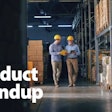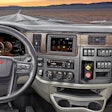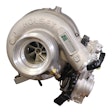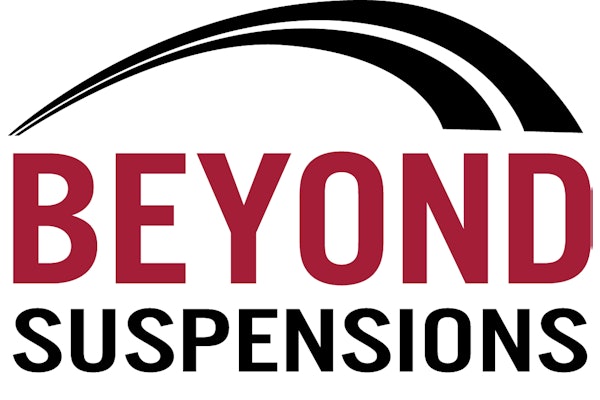At any given time, Steve Phillips has more than 100,000 commercial tires rolling down North American roadways.
As senior vice president of fleet resources at Werner Enterprises, Phillips is responsible for maintaining more than 7,100 trucks and 23,000 trailers for the Omaha, Neb.- based fleet.
With such a large investment on the road, Phillips is constantly looking for an edge.
While there’s no magic product that ensures optimal vehicle performance and fuel economy, there are products in the industry today that can make things a little easier.
There are ways for fleets to save money.
One area where Phillips has found salvation is tire pressure stability.
Over the last 25 years, tire pressure monitoring and inflation products have entered and permeated the North American fleet marketplace. With more than 40 manufacturers, the technology is among the most accepted and popular options for improving fuel economy (and tire performance) for today’s fleets.
It’s also become one of the most proven.
“These products offer [fleets] a return on investment of a little more than a year,” says Mike Roeth, executive director of the North American Council for Freight Efficiency (NACFE).
Formed specifically to provide independent third-party research to fleets on fuel efficient technologies, NACFE tackled tire pressure in a Confidence Report in 2012.
After nearly a year of research, NACFE found tire pressure systems offer an average 14 month payback. Roeth says that’s an enticing number for fleets and the distributors who sell to them.
In an industry filled with unknown and unproven fuel efficient solutions, tire pressure systems offer distributors a product customers can count on.
“This current generation of products work really well,” Roeth says. “They’ve improved greatly over time.”
He says that’s something fleets were quick to point out during NACFE’s research. “We didn’t test all the products [in the market] with respect to reliability, but reliability in general is very good given what fleets told us.”
Extensive testing is one reason for the dependability, says Frank Sonzala, executive vice president at Pressure Systems International (PSI).
PSI entered the tire pressure business in the early 1990s. Its automatic tire inflation system was one of the first to debut in the market.
Sonzala says the product and its manufacturer were met with some uncertainty at the time — to this day, PSI manufactures only one product — but customers were interested. Early adopters added the system to trailers for pilot programs, and watched as the tests consistently showed success.
The same was true at PressurePro, which used a successful launch in the light-duty industry as a springboard to heavy-duty.
“Tire pressure monitoring started to become significant during the Ford and Firestone tire issues,” says Phillip Zaroor, president and CEO at PressurePro, referring to a major under-inflation problem found in Firestone tires on Ford vehicles in the late 1990s.
“That’s really when tire pressure monitoring came to the forefront. People realized how valuable it could be on their vehicles.”
TJ Thomas, director of marketing and customer solutions, Controls Group, at Bendix, says his company’s TPMS system is designed to provide customers as much real-time information as possible.
“The system can alert a driver to a loss of tire air pressure or of a dangerously high tire temperature. It also can provide pressure information to maintenance personnel to ensure optimum operating conditions,” he says. “[And] when connected to a tractor equipped with telematics, the alerts can be wirelessly transmitted to the fleet’s back office for analysis.”
And the evolution and improvements to the systems available today have only made them more enticing, Sonzala says.
“There’s so much more to having your tires properly inflated than just fuel economy,” he says. “Some of our custom- ers have started to advertise that they have automatic tire inflation systems when they are recruiting.”
“It’s a selling point that “the driver never has to touch a tire,” he says.
Coupled with a clear return on investment, Sonzala says both offer clear selling points for a distributor.
Roeth says ROI proved to be huge part of NACFE’s research. While there were ROI variances across products, an overall theme of profitability was clear.
“Poor tire pressure costs a fleet as much as one roadside breakdown per truck, per year,” he says. “So there’s a $300 to $400 repair, but you also can improve your fuel economy by more than $200 [per year] with these systems … so the return on investment doesn’t take that long.”
Bendix estimates tire pressure monitoring also saves fleets 42 hours per vehicle, per year in manual tire pressure checks, Thomas says.
Phillips says ROI was one of the driving factors in Werner’s decision to retrofit most of its trailers in 2010.
“We knew the return on investment was there,” he says. “That was important to us.”
The fleet is now spec’ing automatic tire inflation systems into its new units as well, and Phillips says more than 16,000 of Werner’s trailers have some type of tire pressure system.
The affordability of today’s systems also helps sell customers who otherwise would prefer to spec a new product over a retrofit addition, says Josh Carter, CEO at Aperia Technologies.
Proactive maintenance fleets are usually good at understanding that retrofitting is an investment, not a cost, he says.
But for fleets that still see new, beneficial technology as an expense, a quick and predictable return on investment can be a huge help in completing a sale.
“A lot of times it’s in the interest of fleets to roll these systems into the financing of new equipment,” Carter says. “So any time you’re looking at a new project that’s unique and requires special attention … you need to be able to clearly prove to them that it’s worth it.”
“If a [fleet manager] is going to spend money on something, he needs to know what it is going to do for him,” adds Zaroor.
Customers also can be sold on the simplicity of these products.
With installation times running from 10 minutes to a few hours, it doesn’t take long to retrofit a trailer and get it back on the road.
Many of today’s manufacturers offer simple training programs to educate distributors and end-user customers on installation best practices, and some manufacturers also have professional technicians that can be dispatched to assist in a major fleet retrofit.
That customer support is built into the price of the product.
“A lot of times when a fleet wants to do a big retrofit and it’s not convenient to have trailers dropped off at a dealer, [the PSI distribution channel] will send a tech out to their terminal to do the installations,” says Sonzala.
“We have fleets we’ve trained that are knocking out retrofits in 40 minutes or less,” says Zaroor.
Post-installation maintenance is another good selling point, adds Carter, because in most cases there isn’t any.
Thomas says 90 percent of all tire failures are caused by under-inflation, and nearly half of all emergency service calls are tire related. But tires that are properly inflated rarely break down.
“I think these products are capable of eliminating tire under-inflation,” Carter says. “And if you can show customers the system will always maintain pressure, you’ve convinced them already. Because then they connect the dots in their head about what that means.”
“Our initial study [on tire pressure] was strictly on tread wear,” adds Phillips. “We saw enough improvements there
to go with the system, but when your tires are fully inflated you’re also going to get better MPG and less damage on the road.”
Roeth says the combination of each benefit — proven products, consistent return on investment, improved tire life and fuel economy — truly makes tire pressure monitoring work.
In an industry filled with uncertainty, the products offer welcome consistency.
Phillips says that’s something he’d recommend to any of his fleet contemporaries.
“It was pretty straightforward for us,” he says. “We did our testing, found that [the technology] worked and started installing it.”
Adds Roeth, “I think tire pressure systems are one [fuel efficient] technology where we’re at a place where what is in production is very reliable, and fleets are very comfortable using it.
“Fleets value these systems pretty highly.”











